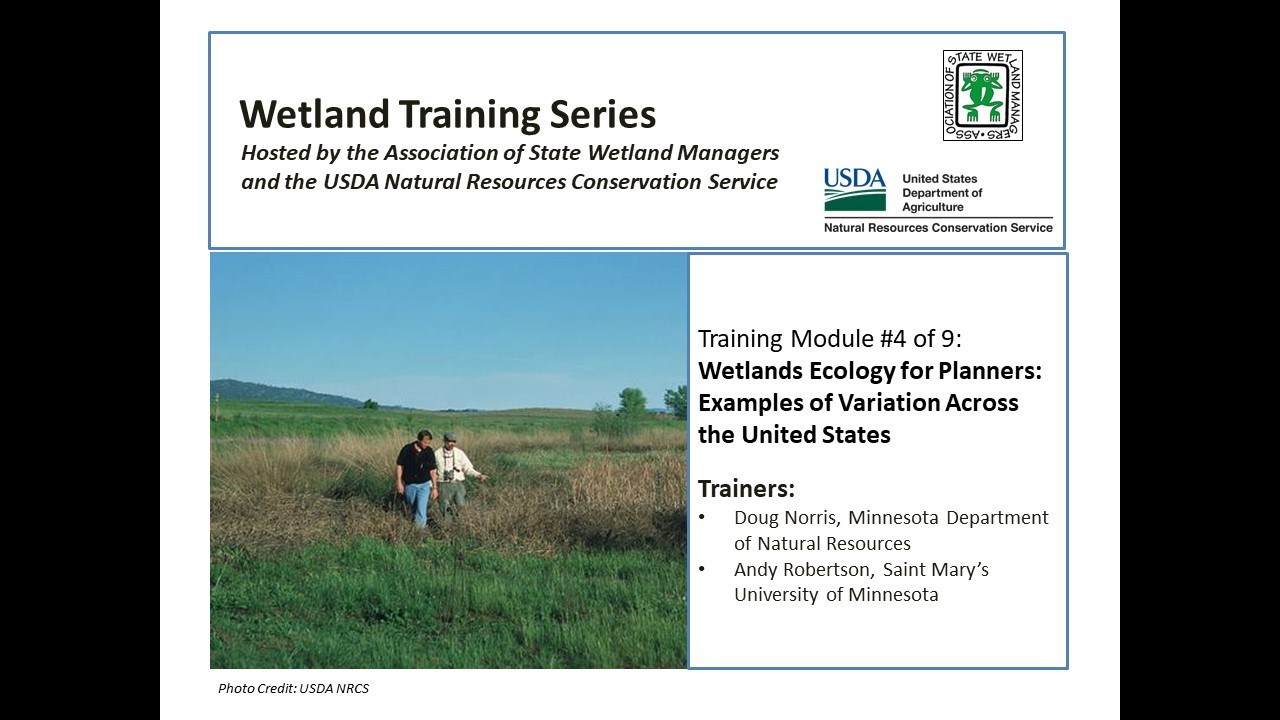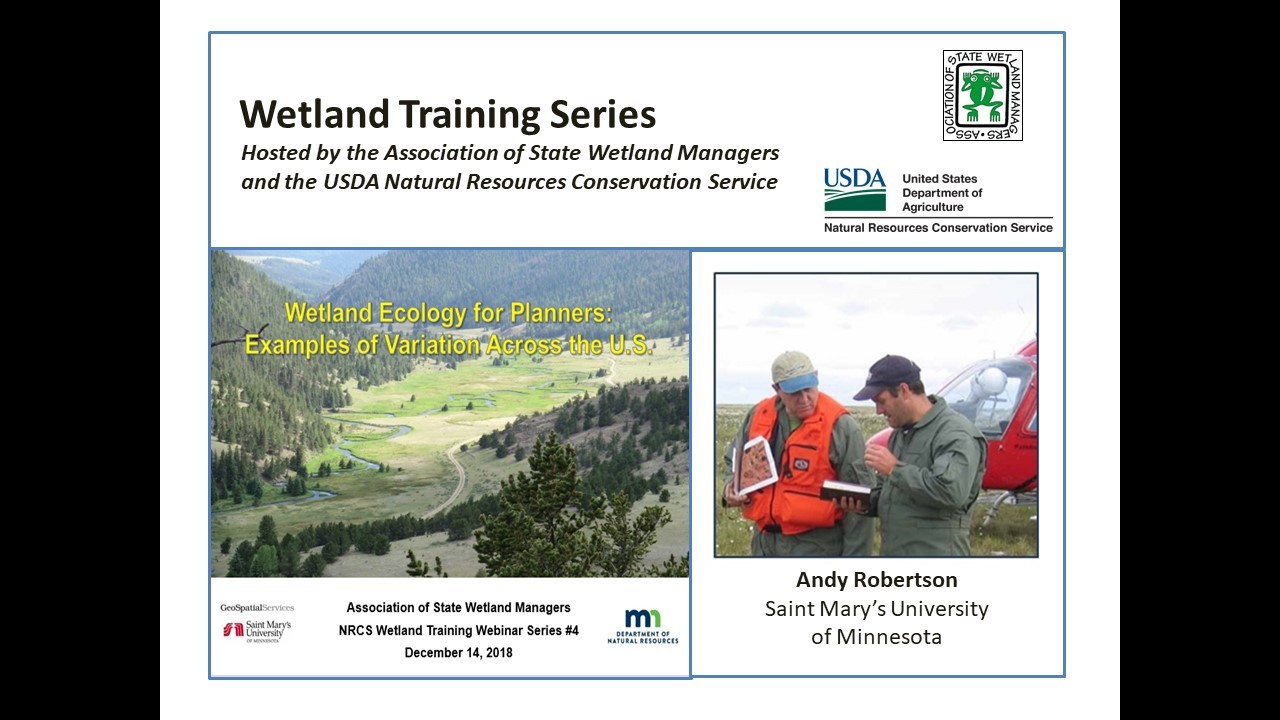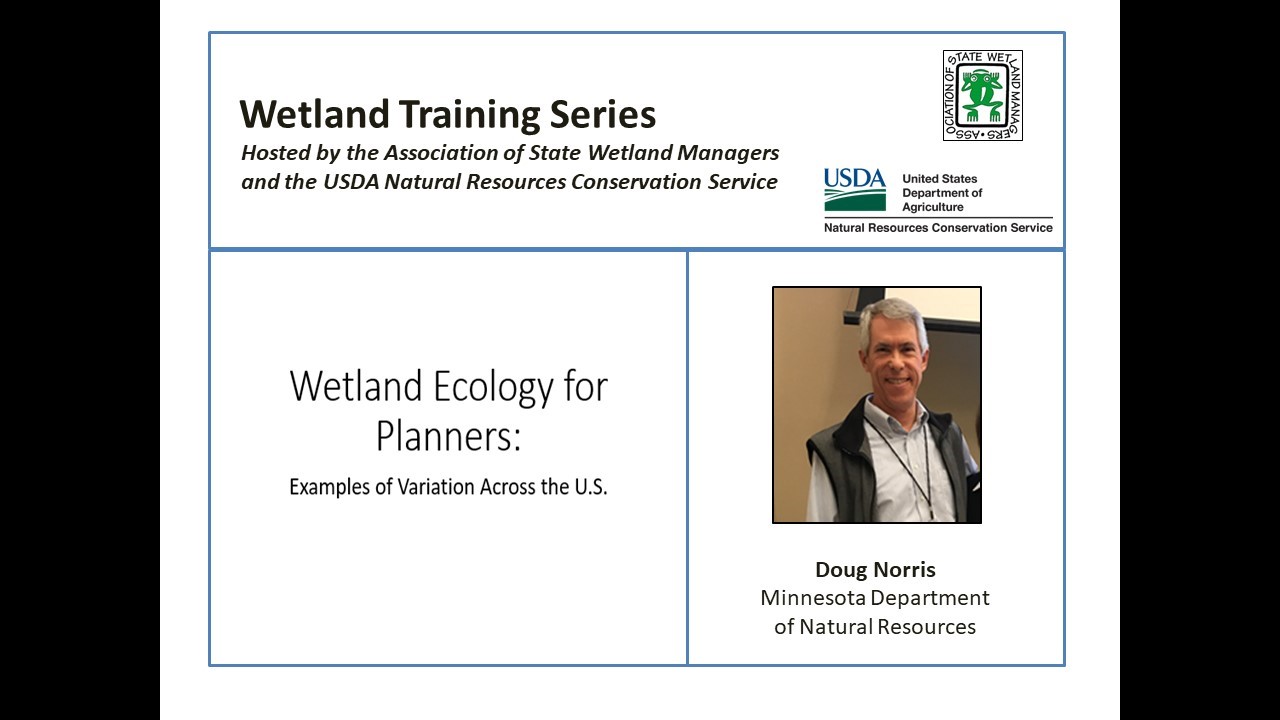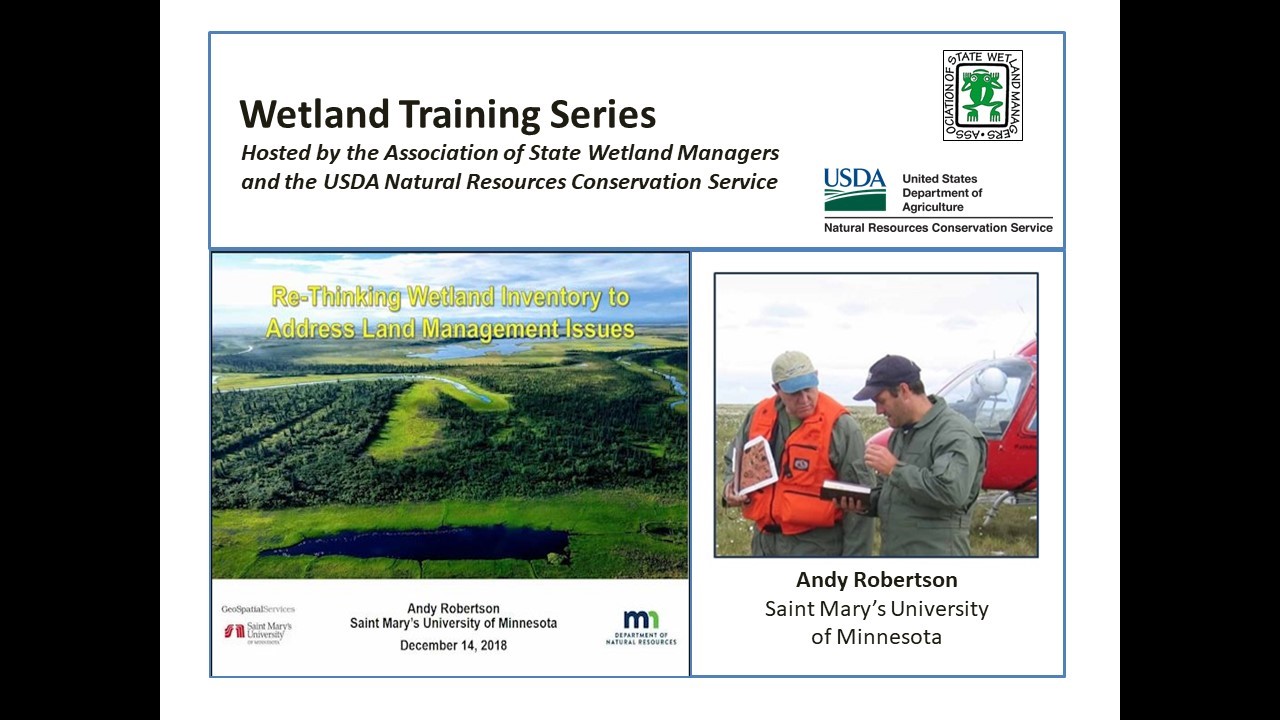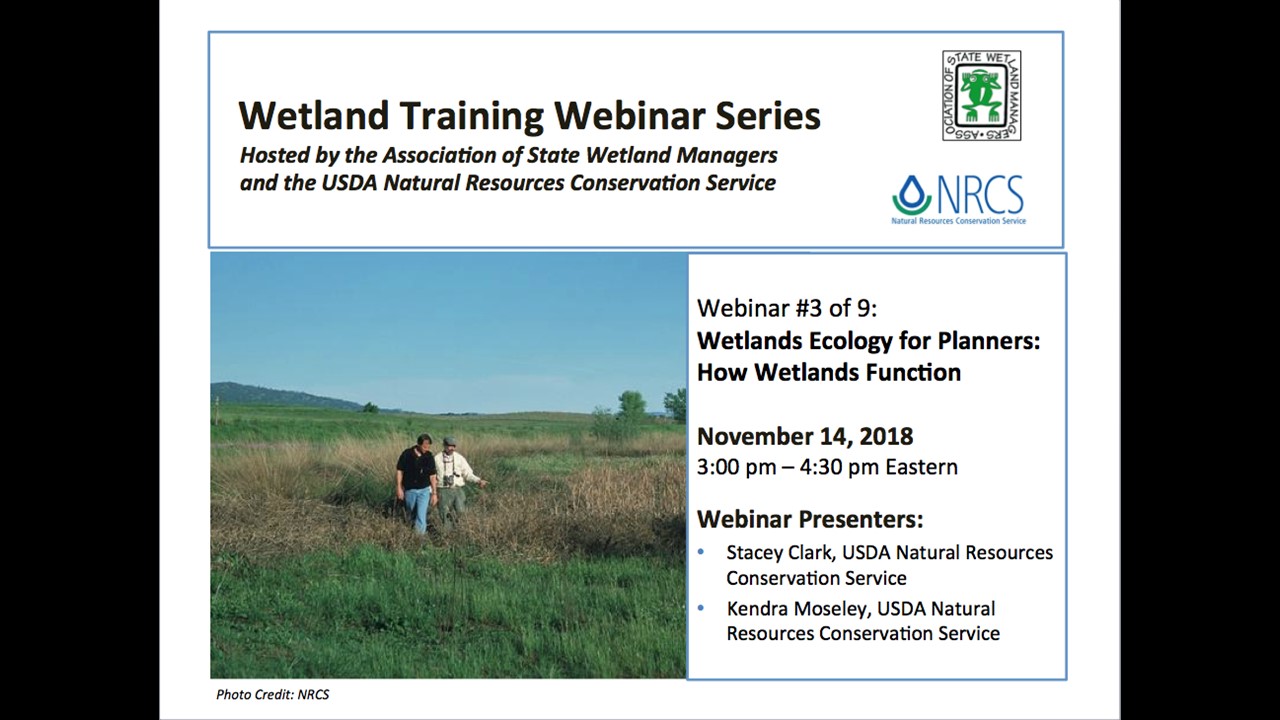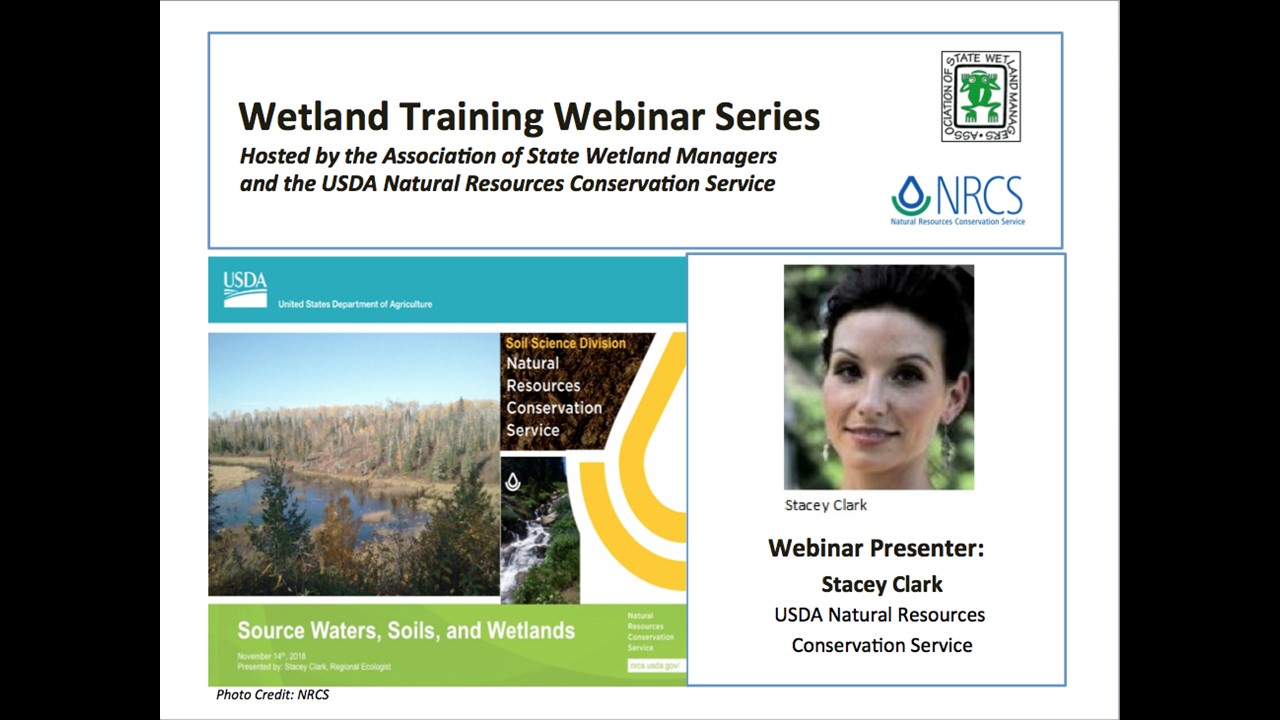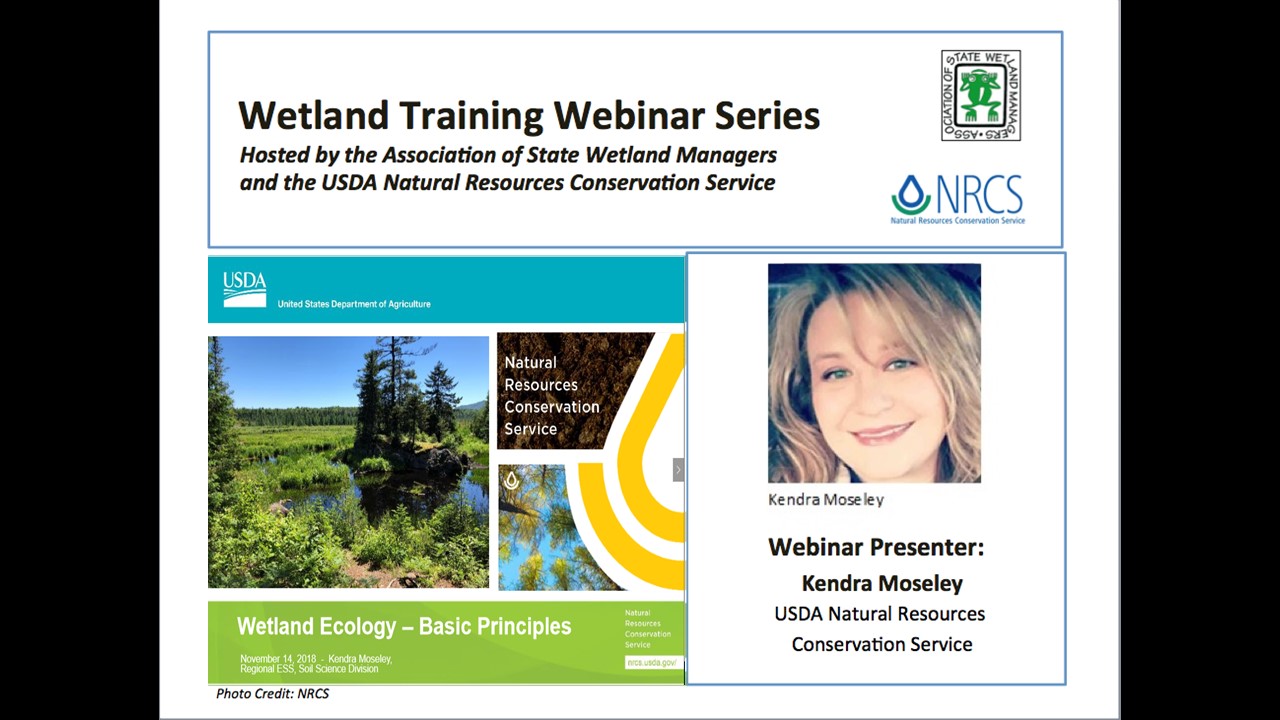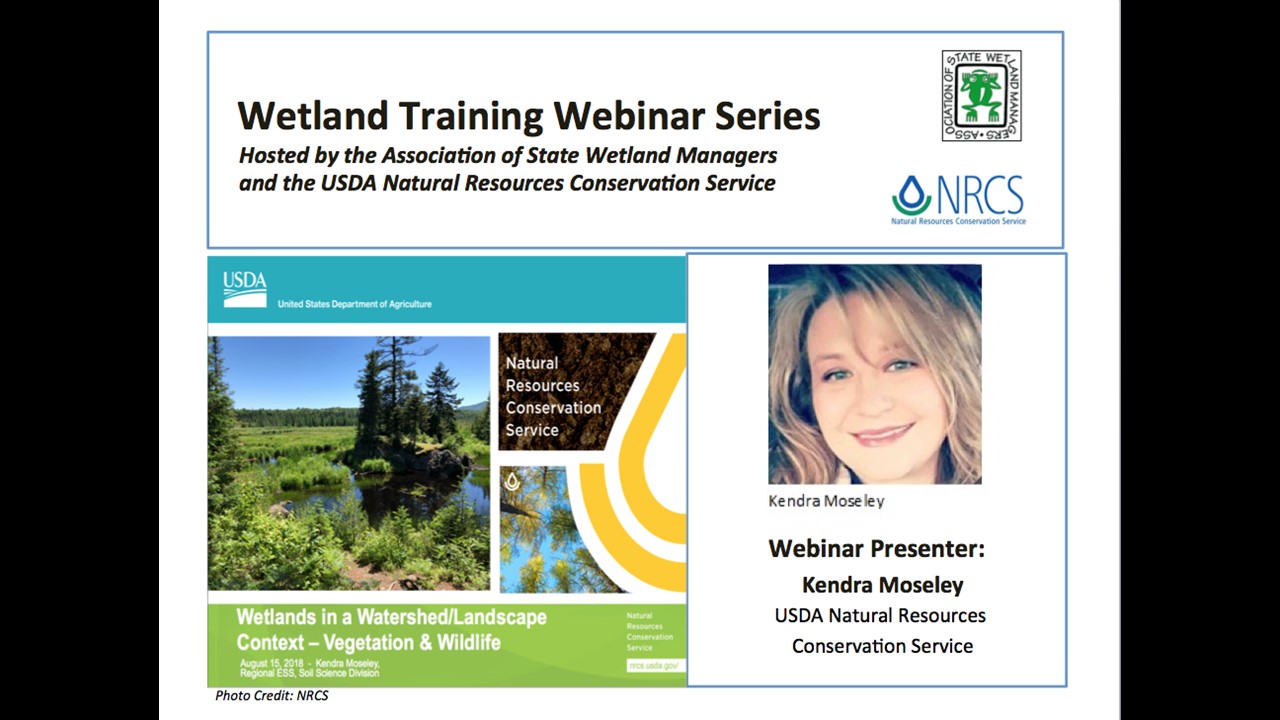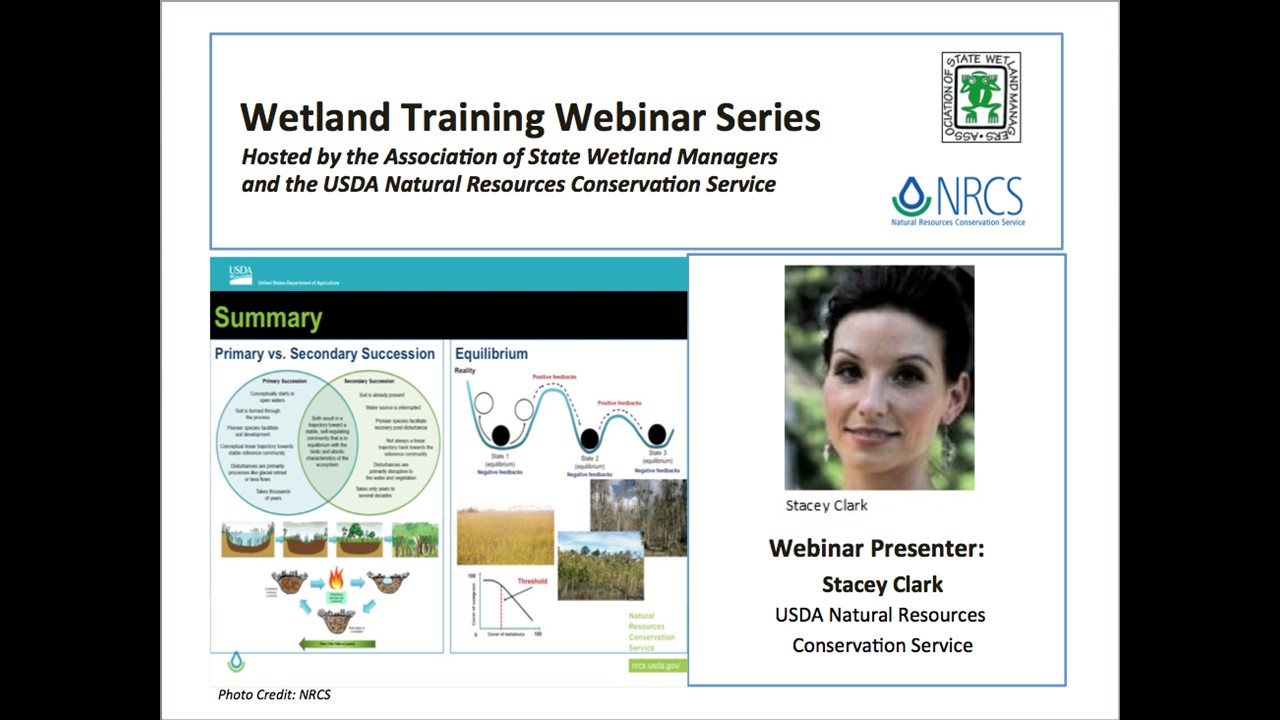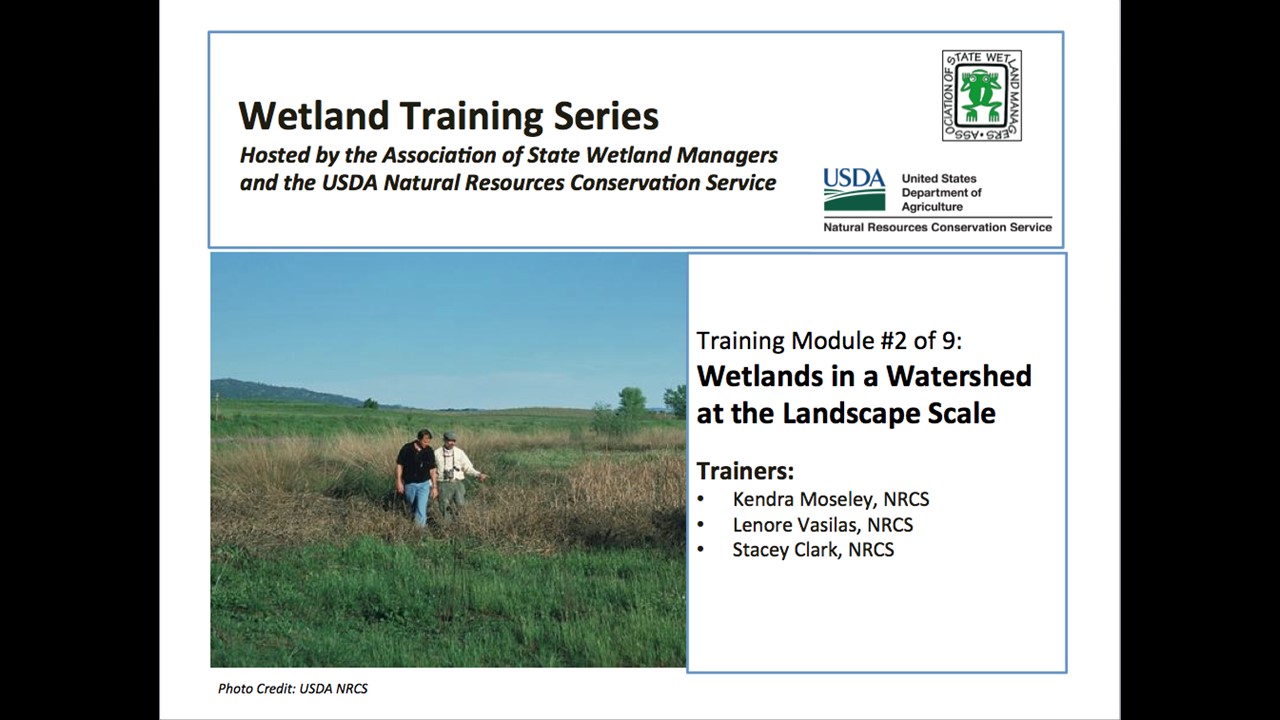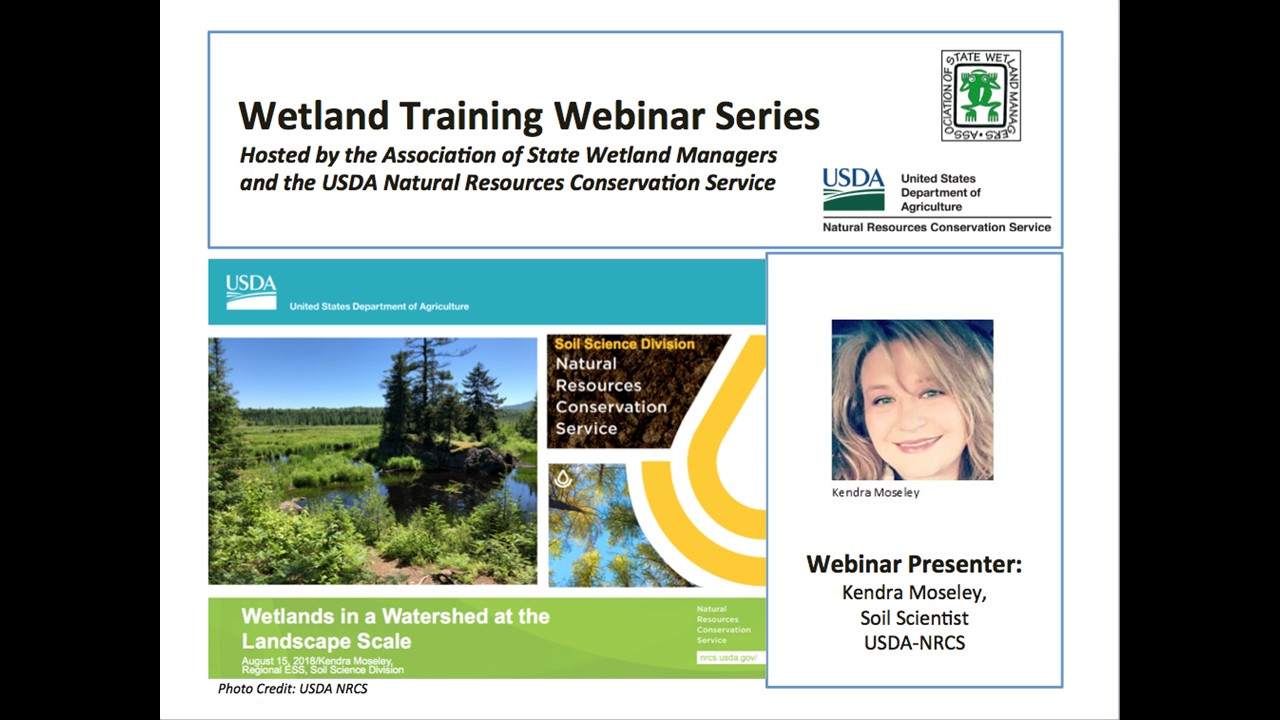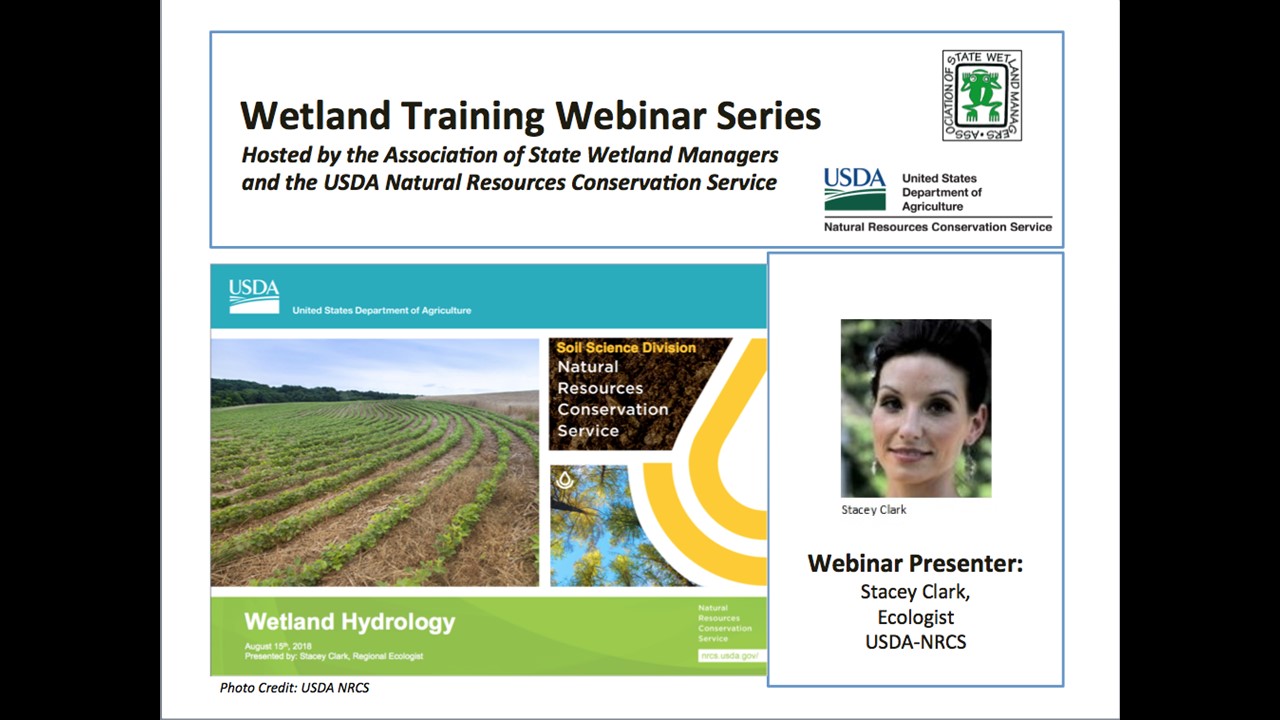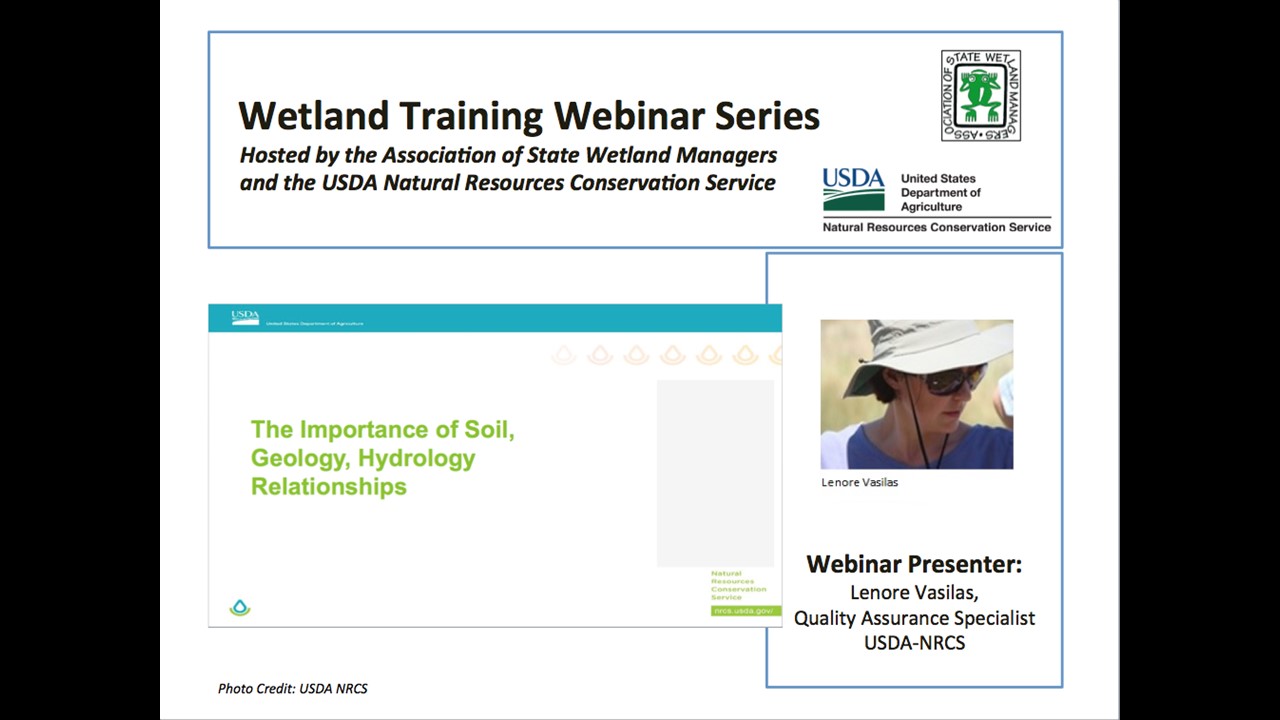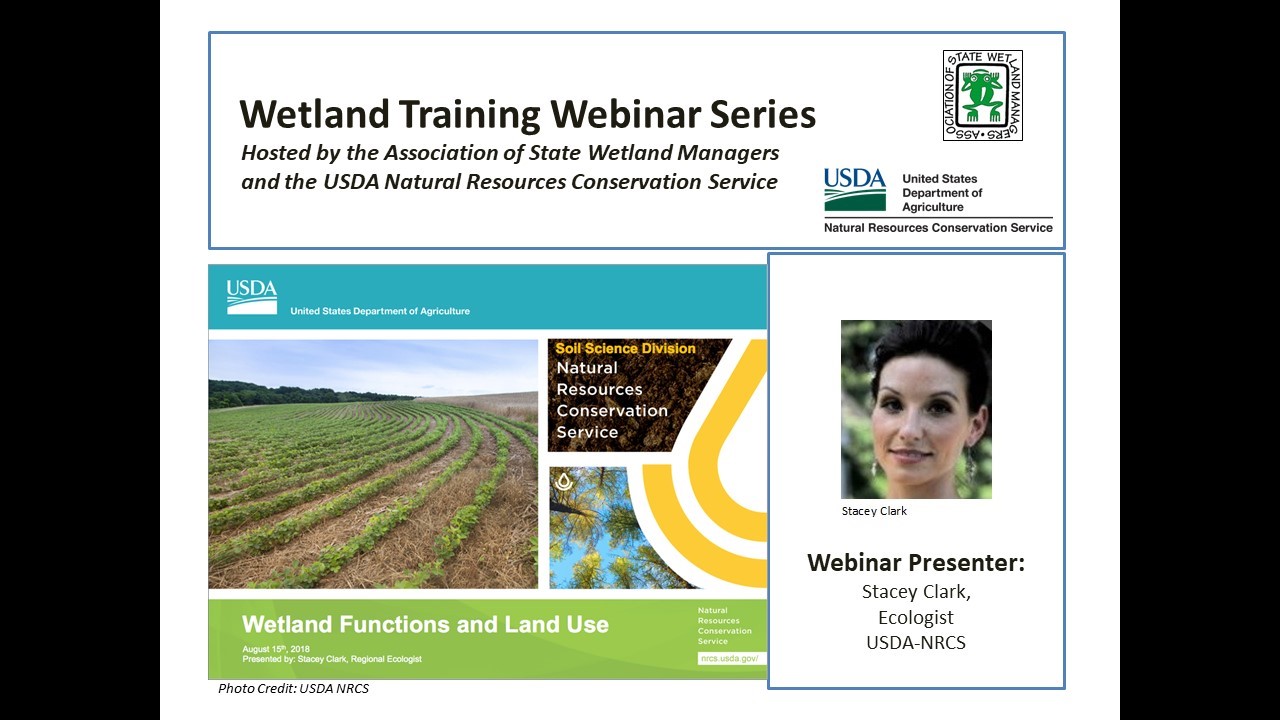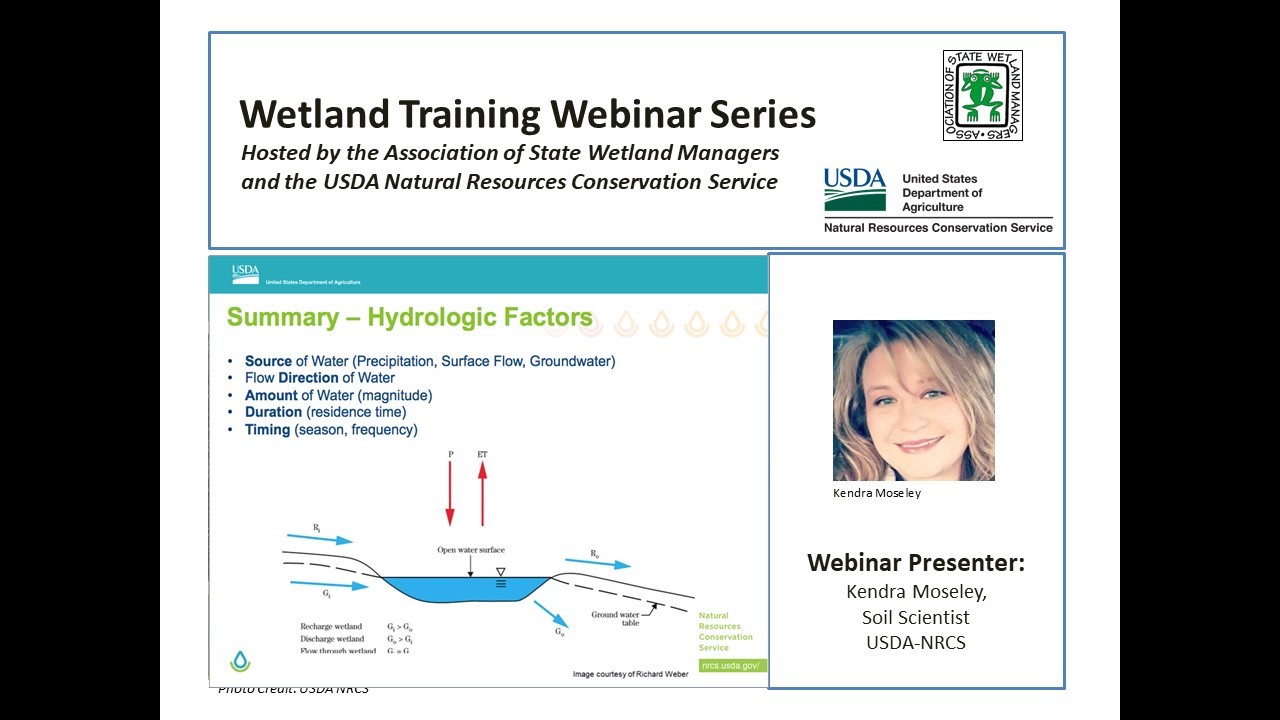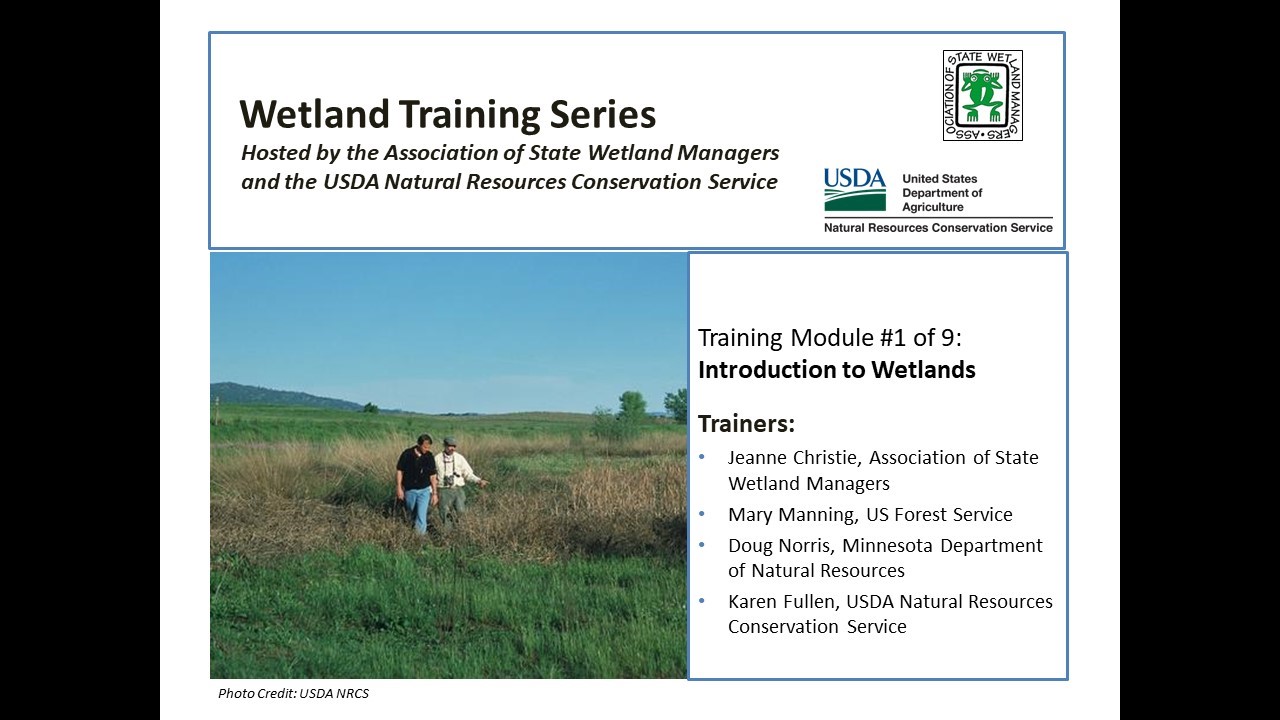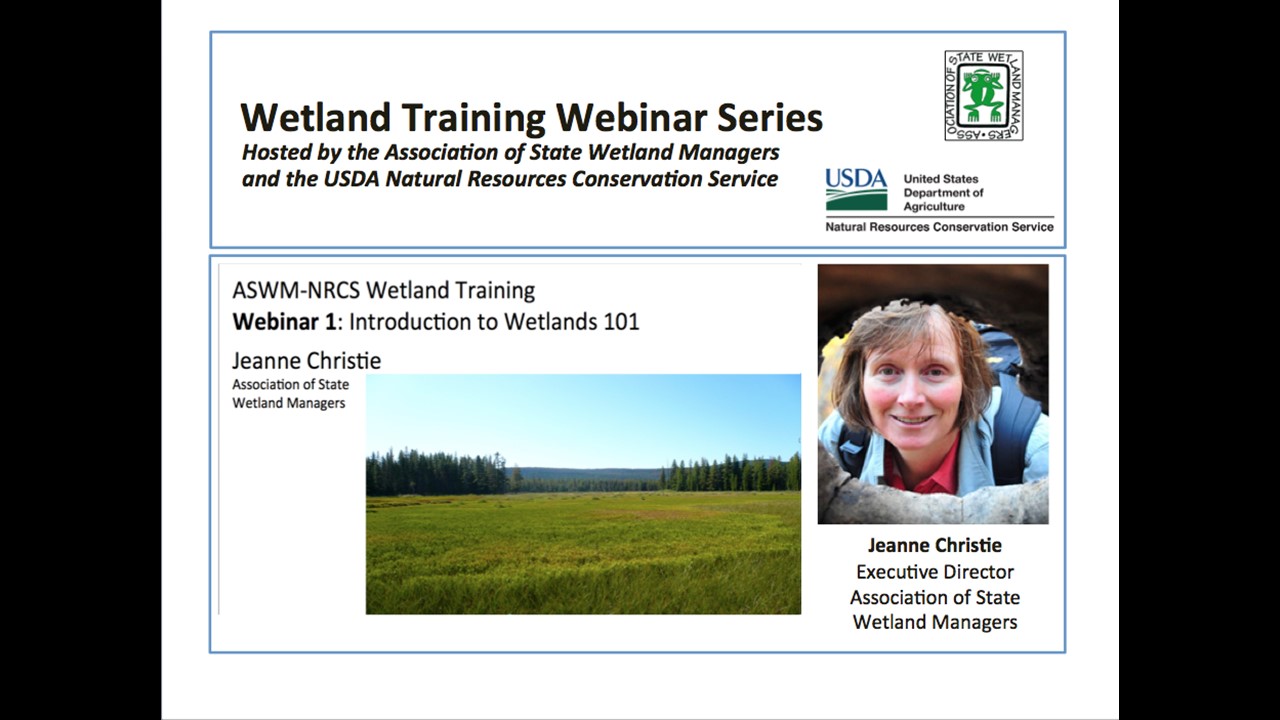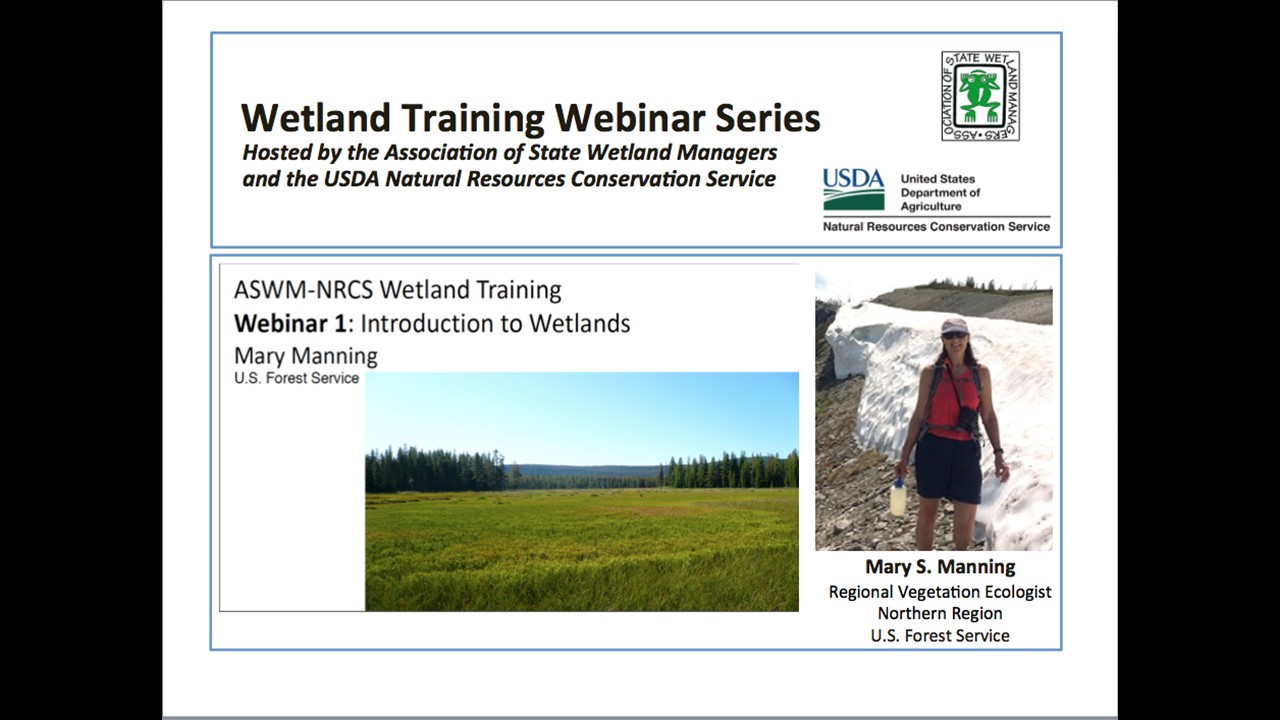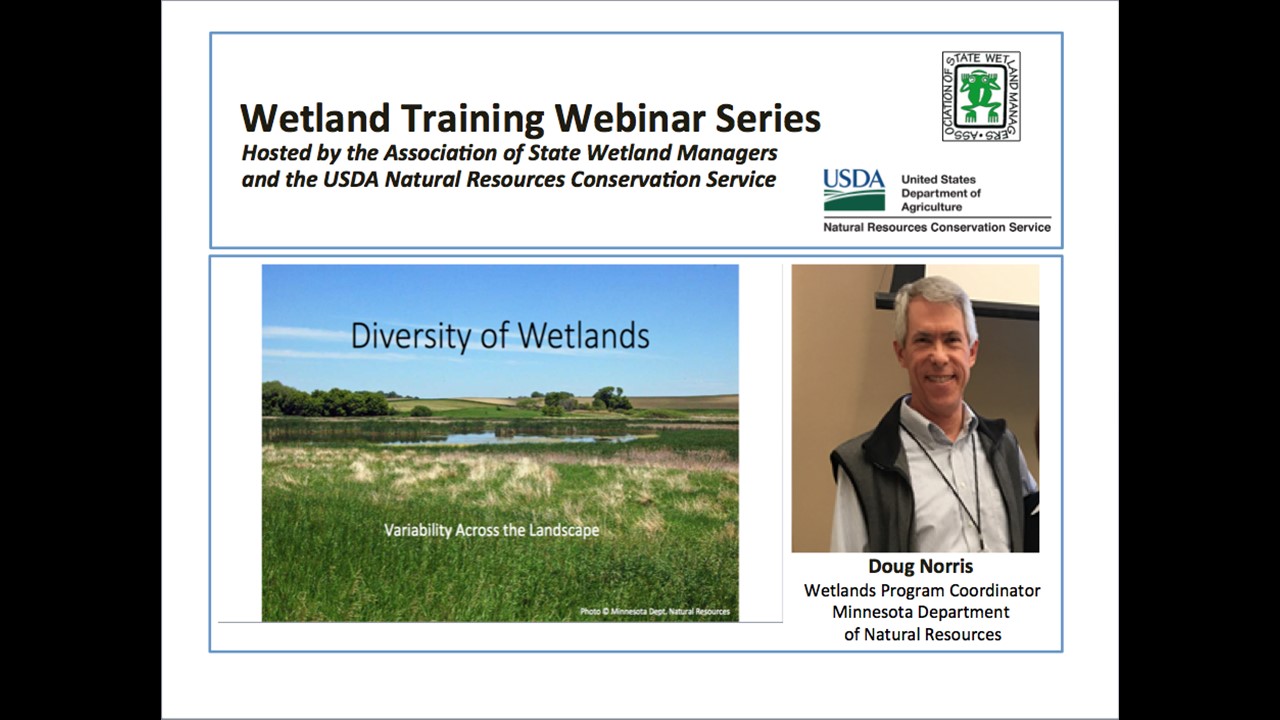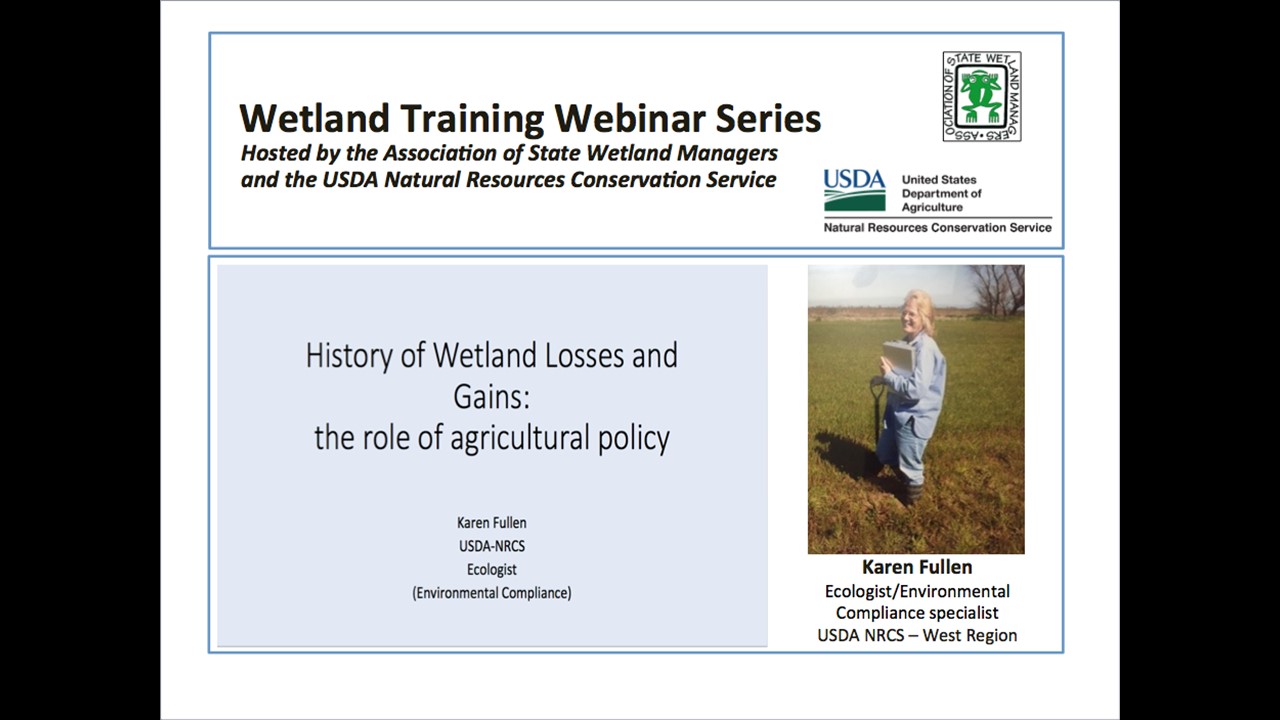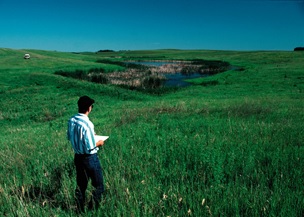 Webinar 4: Wetlands Ecology for Planners - Examples of Variation Across the United States
Webinar 4: Wetlands Ecology for Planners - Examples of Variation Across the United States
Held Friday, December 14, 2018 at 3:00-5:00 pm ET
INTRODUCTION
Jeanne Christie, National Association of Wetland Managers [POWERPOINT PRESENTATION]
PRESENTERS
- Doug Norris, Wetland Program Coordinator, Minnesota Department of Natural Resources [POWERPOINT PRESENTATION]
- Andy Robertson, Executive Director, Geospatial Services, Saint Mary’s University of Minnesota [POWERPOINT PRESENTATION]
ABSTRACT
This is the fourth webinar in NAWM and NRCS’s jointly-developed nine-part wetland training webinar series. The webinar began with a presentation on the variability in wetlands across the country, including how specific wetland functions and services vary by wetland type. The webinar reviewed these functions and services, which include wildlife habitat, flood attenuation, water quality improvement, recreational opportunities and more. The webinar then move to a second presentation on wetland benefits and their impact on other resources at the watershed scale. This topic was explored through three cases examining how climatic fluctuation, flooding and water quality are impacted by the presence and/or absence of wetlands (wetland loss/wetland restoration). Participants will come away from the webinar with an increased understanding of variability of wetlands and their associated functions and services nationwide, as well as how wetland loss and wetland restoration can have impacts at the watershed scale.
BIOS
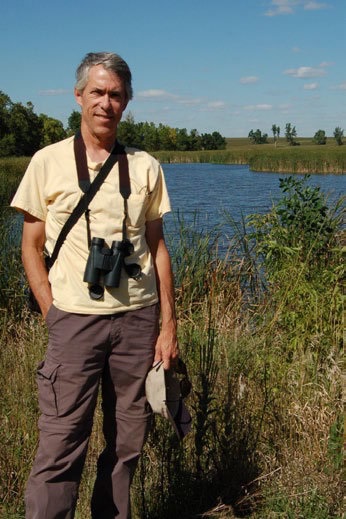 Doug Norris is the Wetlands Program Coordinator for the Minnesota Department of Natural Resources in St. Paul, Minnesota. His responsibilities include wetland policy development, providing technical assistance on wetlands, developing wetlands-related data such as updated National Wetland Inventory maps and wetland status and trend data, and administering the DNR’s regulatory responsibilities for calcareous fens. Doug held previous positions with the St. Paul District, Corps of Engineers and for the U.S. Fish and Wildlife Service in Bloomington, Indiana. He graduated from Purdue University (B.S. -Wildlife) and from the University of Missouri (M.S. - Fisheries and Wildlife).
Doug Norris is the Wetlands Program Coordinator for the Minnesota Department of Natural Resources in St. Paul, Minnesota. His responsibilities include wetland policy development, providing technical assistance on wetlands, developing wetlands-related data such as updated National Wetland Inventory maps and wetland status and trend data, and administering the DNR’s regulatory responsibilities for calcareous fens. Doug held previous positions with the St. Paul District, Corps of Engineers and for the U.S. Fish and Wildlife Service in Bloomington, Indiana. He graduated from Purdue University (B.S. -Wildlife) and from the University of Missouri (M.S. - Fisheries and Wildlife).
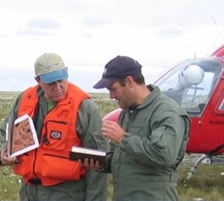 Andy Robertson is currently Executive Director of GeoSpatial Services at Saint Mary’s University of Minnesota. In this role, Andy is responsible for oversight and management of all GeoSpatial Services projects, activities and staff. GeoSpatial Services is engaged in a wide variety of projects across the Lower 48 and Alaska including: wetland inventory; National Hydrography Dataset updates; spatial data development; and, natural resource condition assessments. Andy earned a Forest Technology Diploma from Sault College of Applied Technology in Ontario, Canada, a B.Sc. in Environmental Science from the University of Waterloo and completed postgraduate work in forest management at the University of Toronto. GeoSpatial Services has been a key partner of the USFWS and has been working for over 15 years to update legacy National Wetland Inventory data across the nation. Andy is a steering committee member for the NAWM Wetland Mapping Consortium and is co-chair of the Alaska GeoSpatial Council Wetland Technical Working Group.
Andy Robertson is currently Executive Director of GeoSpatial Services at Saint Mary’s University of Minnesota. In this role, Andy is responsible for oversight and management of all GeoSpatial Services projects, activities and staff. GeoSpatial Services is engaged in a wide variety of projects across the Lower 48 and Alaska including: wetland inventory; National Hydrography Dataset updates; spatial data development; and, natural resource condition assessments. Andy earned a Forest Technology Diploma from Sault College of Applied Technology in Ontario, Canada, a B.Sc. in Environmental Science from the University of Waterloo and completed postgraduate work in forest management at the University of Toronto. GeoSpatial Services has been a key partner of the USFWS and has been working for over 15 years to update legacy National Wetland Inventory data across the nation. Andy is a steering committee member for the NAWM Wetland Mapping Consortium and is co-chair of the Alaska GeoSpatial Council Wetland Technical Working Group.
Webinar 3: Wetlands Ecology for Planners - How Wetlands Function
Held Wednesday, November 14, 2018 at 3:00-4:30 pm ET
INTRODUCTION
- Brenda Zollitsch, Policy Analyst, National Association of Wetland Managers [POWERPOINT PRESENTATION]
- Stacey Clark, USDA Natural Resources Conservation Service [POWERPOINT PRESENTATIONS]
PRESENTERS
- Stacey Clark, USDA Natural Resources Conservation Service [POWERPOINT PRESENTATION] SUMMARY [POWERPOINT PRESENTATION]
- Kendra Moseley, USDA Natural Resources Conservation Service [POWERPOINT PRESENTATION]
ABSTRACT
This is the third webinar in NAWM and NRCS’s jointly-developed nine-part wetland training webinar series. The first half of the webinar focused on explaining general wetland ecology concepts, including succession, thresholds, disturbance, sensitivity and resilience. The second half of the webinar identified how source waters (surface and groundwater) and soils define the character of a wetland, including an introduction to the Hydrogeomorphic Wetland Classification System (HGM). Participants will come away from the webinar with an increased understanding of how to consider these key concepts as they plan conservation and management activities that include wetlands.
BIOS
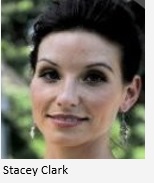 Stacey Clark is a USDA Natural Resources Conservation Service Ecologist. Stacey has been an ecologist for NRCS since 2011. From 2008-2011, she served as a plant ecologist for the Minnesota Department of Natural Resources. Prior to this, she worked as a Forestry Technician with the U.S. Forest Service. Stacey holds a Master’s degree in Forest Ecology from the University of Minnesota – Twin Cities and a Bachelor of Science in Animal Sciences and Zoology from Michigan State University.
Stacey Clark is a USDA Natural Resources Conservation Service Ecologist. Stacey has been an ecologist for NRCS since 2011. From 2008-2011, she served as a plant ecologist for the Minnesota Department of Natural Resources. Prior to this, she worked as a Forestry Technician with the U.S. Forest Service. Stacey holds a Master’s degree in Forest Ecology from the University of Minnesota – Twin Cities and a Bachelor of Science in Animal Sciences and Zoology from Michigan State University.
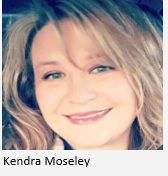 Kendra Moseley is a USDA Natural Resources Conservation Service Quality Assurance Specialist focused on the development of ecological site concepts and ecological site descriptions. Her area of responsibility is from Alaska, the Pacific NW, California, Nevada, and down to Hawaii and the Pacific Islands Area. She works to ensure that all ecological site work being conducted in relation to the NRCS, including all agency projects, interagency MOUs, contract agreements, and research projects meet the existing NRCS National standards, policies, and guidelines. Kendra has been involved in the development of many of the national standards and guidelines that currently exist related to the development of ecological site concepts and site descriptions. Kendra holds both her Master of Science in Restoration Ecology and her Bachelor of Science in Rangeland Ecology and Management from the University of Idaho.
Kendra Moseley is a USDA Natural Resources Conservation Service Quality Assurance Specialist focused on the development of ecological site concepts and ecological site descriptions. Her area of responsibility is from Alaska, the Pacific NW, California, Nevada, and down to Hawaii and the Pacific Islands Area. She works to ensure that all ecological site work being conducted in relation to the NRCS, including all agency projects, interagency MOUs, contract agreements, and research projects meet the existing NRCS National standards, policies, and guidelines. Kendra has been involved in the development of many of the national standards and guidelines that currently exist related to the development of ecological site concepts and site descriptions. Kendra holds both her Master of Science in Restoration Ecology and her Bachelor of Science in Rangeland Ecology and Management from the University of Idaho.
![]()
Webinar 2: Wetlands in a Watershed at the Landscape Scale
Held Wednesday, August 15, 2018 at 3pm ET
INTRODUCTION
- Brenda Zollitsch, Policy Analyst, National Association of Wetland Managers
[POWERPOINT PRESENTATION] - Kendra Moseley, USDA Natural Resources Conservation Service [POWEROINT PRESENTATION]
PRESENTERS
- Kendra Moseley, USDA Natural Resources Conservation Service
- Wetlands in a Watershed/Landscape Context - Vegetation & Wildlife [POWERPOINT PRESENTATION]
- Summary [POWERPOINT PRESENTATION]
- Lenore Vasilas, USDA Natural Resources Conservation Service [POWERPOINT PRESENTATION]
- Stacey Clark, USDA Natural Resources Conservation Service
- Wetland Functions and Land Use [POWERPOINT PRESENTATION]
- Wetland Hydrology [POWERPOINT PRESENTATION]
ABSTRACT
This second webinar in NAWM and NRCS’s jointly-developed nine-part wetland training webinar series began with an overview of where wetlands can occur in landscapes. Next, the webinar explored the three key considerations with wetlands – hydrology, geology (soils), and vegetation. The presenters covered the importance of hydrology for wetlands, including temporal changes and the importance of time scale, the soil-water relationship and parent/source materials when looking at hydric soils, as well as kinds of wetland plants and what plant patterns tell you about how water runs off the land and the wetland itself. This webinar also covered influences from specific living resources, how different land uses affect wetlands (with a focus on agricultural land use), and how wetlands are a reflection of their surrounding landscape and watershed. The webinar concluded with discussion on how wetlands change over time and tools that can be used to understand these changes. Participants will come away from the webinar with an increased understanding of patterns on the landscape, how to identify wetlands at the watershed and field level and prepare to look at individual wetland sites.
BIOS
 Kendra Moseley is a USDA Natural Resources Conservation Service Quality Assurance Specialist focused on the development of ecological site concepts and ecological site descriptions. Her area of responsibility is from Alaska, the Pacific NW, California, Nevada, and down to Hawaii and the Pacific Islands Area. She works to ensure that all ecological site work being conducted in relation to the NRCS, including all agency projects, interagency MOUs, contract agreements, and research projects meet the existing NRCS National standards, policies, and guidelines. Kendra has been involved in the development of many of the national standards and guidelines that currently exist related to the development of ecological site concepts and site descriptions. Kendra holds both her Master of Science in Restoration Ecology and her Bachelor of Science in Rangeland Ecology and Management from the University of Idaho.
Kendra Moseley is a USDA Natural Resources Conservation Service Quality Assurance Specialist focused on the development of ecological site concepts and ecological site descriptions. Her area of responsibility is from Alaska, the Pacific NW, California, Nevada, and down to Hawaii and the Pacific Islands Area. She works to ensure that all ecological site work being conducted in relation to the NRCS, including all agency projects, interagency MOUs, contract agreements, and research projects meet the existing NRCS National standards, policies, and guidelines. Kendra has been involved in the development of many of the national standards and guidelines that currently exist related to the development of ecological site concepts and site descriptions. Kendra holds both her Master of Science in Restoration Ecology and her Bachelor of Science in Rangeland Ecology and Management from the University of Idaho.
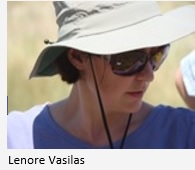 Lenore Vasilas is a USDA Natural Resources Conservation Service Soil Scientist on the Soil Science Division Technical Soil Services Staff. She has been a soil scientist for NRCS for 28 years working for the first 7 years on soil survey and the rest of her career in various positions, concentrating on hydric soils issues. She has been a member of the National Technical Committee for Hydric Soils for 20 years and is the current chair of the committee.
Lenore Vasilas is a USDA Natural Resources Conservation Service Soil Scientist on the Soil Science Division Technical Soil Services Staff. She has been a soil scientist for NRCS for 28 years working for the first 7 years on soil survey and the rest of her career in various positions, concentrating on hydric soils issues. She has been a member of the National Technical Committee for Hydric Soils for 20 years and is the current chair of the committee.
 Stacey Clark is a USDA Natural Resources Conservation Service Ecologist. Stacey has been an ecologist for NRCS since 2011. From 2008-2011, she served as a plant ecologist for the Minnesota Department of Natural Resources. Prior to this, she worked as a Forestry Technician with the U.S. Forest Service. Stacey holds a Master’s Degree in Forest Ecology from the University of Minnesota – Twin Cities and a Bachelor of Science in Animal Sciences and Zoology from Michigan State University.
Stacey Clark is a USDA Natural Resources Conservation Service Ecologist. Stacey has been an ecologist for NRCS since 2011. From 2008-2011, she served as a plant ecologist for the Minnesota Department of Natural Resources. Prior to this, she worked as a Forestry Technician with the U.S. Forest Service. Stacey holds a Master’s Degree in Forest Ecology from the University of Minnesota – Twin Cities and a Bachelor of Science in Animal Sciences and Zoology from Michigan State University.
Webinar 1: Introduction to Wetlands
Held Friday, June 22, 2018 at 3pm ET
INTRODUCTION
- Jeanne Christie, Executive Director, Association of State Wetland Mangers
- Brenda Zollitsch, Policy Analyst, National Association of Wetland Managers
[POWERPOINT PRESENTATION]
PRESENTERS
- Mary Manning, US Forest Service [POWERPOINT PRESENTATION]
- Doug Norris, Minnesota Department of Natural Resources [POWEROINT PRESENTATION]
- Karen Fullen, USDA Natural Resources Conservation Service [POWERPOINT PRESENTATION]
WEBINAR DISCUSSION
This first webinar in NAWM and NRCS’s jointly developed nine-part wetland training webinar series provided an introduction to wetlands. The webinar started with introducing the primary components of a wetland, moving on to what makes wetlands distinctive from other types of waters and land. Next, the webinar covered the variability of wetlands across the landscape, including across seasons and time and the benefits of wetlands. The training concluded with a discussion of the history of and changes in agriculture policy in relation to wetland losses and gains. By the end of the webinar, participants will be able to describe what a wetland is and be able to explain to others the value of wetlands.
BIOS
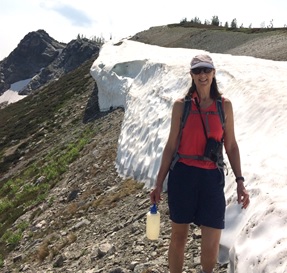 Mary Manning is the Regional Vegetation Ecologist for the Northern Region of the US Forest Service, in Missoula, MT. She focuses on vegetation classification, assessment, inventory and monitoring, primarily in shrubland, grassland and riparian/wetland vegetation. She also works on climate change related assessments and forest plan revision.
Mary Manning is the Regional Vegetation Ecologist for the Northern Region of the US Forest Service, in Missoula, MT. She focuses on vegetation classification, assessment, inventory and monitoring, primarily in shrubland, grassland and riparian/wetland vegetation. She also works on climate change related assessments and forest plan revision.
 Doug Norris is the Wetlands Program Coordinator for the Minnesota Department of Natural Resources in St. Paul, Minnesota. His responsibilities include wetland policy development, providing technical assistance on wetlands, developing wetlands-related data such as updated National Wetland Inventory maps and wetland status and trend data, and administering the DNR’s regulatory responsibilities for calcareous fens. Doug held previous positions with the St. Paul District, Corps of Engineers and for the U.S. Fish and Wildlife Service in Bloomington, Indiana. He graduated from Purdue University (B.S. -Wildlife) and from the University of Missouri (M.S. - Fisheries and Wildlife).
Doug Norris is the Wetlands Program Coordinator for the Minnesota Department of Natural Resources in St. Paul, Minnesota. His responsibilities include wetland policy development, providing technical assistance on wetlands, developing wetlands-related data such as updated National Wetland Inventory maps and wetland status and trend data, and administering the DNR’s regulatory responsibilities for calcareous fens. Doug held previous positions with the St. Paul District, Corps of Engineers and for the U.S. Fish and Wildlife Service in Bloomington, Indiana. He graduated from Purdue University (B.S. -Wildlife) and from the University of Missouri (M.S. - Fisheries and Wildlife).
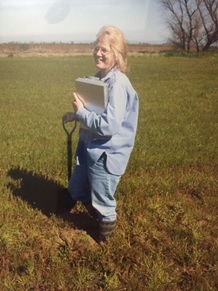 Karen Fullen is the Ecologist and environmental compliance specialist for USDA’s Natural Resources Conservation Service West Region. A native of Fresno, California, Karen started her NRCS career in the Field Office there in 1992 in the student employment programs. After obtaining an A.S. degree in Forest/Park Technology from Kings River Community College and a B.S. in Biology with an Ecology emphasis from Fresno State in 1997, Karen became a Soil Conservationist for the Fresno Field Office. From 1999-2004, she was the Wetland Team Biologist working out of the Elk Grove Field Office to provide wetland compliance and restoration assistance across a large swath of interior northern California. Prior to joining the West National Technology Support Center Core Team in 2014, Karen Fullen served as the State Biologist and Environmental Compliance Specialist for Idaho and Utah over a period of 10 years.
Karen Fullen is the Ecologist and environmental compliance specialist for USDA’s Natural Resources Conservation Service West Region. A native of Fresno, California, Karen started her NRCS career in the Field Office there in 1992 in the student employment programs. After obtaining an A.S. degree in Forest/Park Technology from Kings River Community College and a B.S. in Biology with an Ecology emphasis from Fresno State in 1997, Karen became a Soil Conservationist for the Fresno Field Office. From 1999-2004, she was the Wetland Team Biologist working out of the Elk Grove Field Office to provide wetland compliance and restoration assistance across a large swath of interior northern California. Prior to joining the West National Technology Support Center Core Team in 2014, Karen Fullen served as the State Biologist and Environmental Compliance Specialist for Idaho and Utah over a period of 10 years.
View Past NRCS Conservation Planners Training Webinars Here
View a List of Past NRCS Conservation Planners Training Webinar Recordings Here

